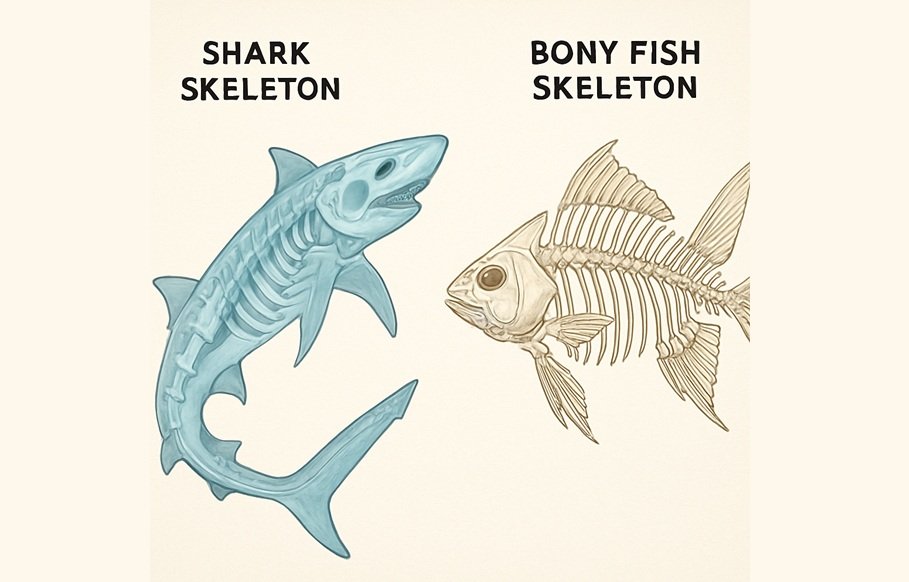
Sharks are fascinating creatures, often misunderstood and surrounded by myths. One common question that arises is whether sharks have bones. This question touches on a deeper understanding of shark anatomy, evolution, and how these creatures have survived for millions of years without the bone structure that most people are familiar with in other animals. So, do sharks have bones? Let’s dive into the details.
Read This: Where Do Camels Store Water?
Shark Anatomy: Cartilage vs. Bone
Sharks, like other cartilaginous fish, do not have bones. Instead, their skeletons are made of cartilage, a flexible and lightweight tissue that is different from bone. Cartilage is the same material that makes up parts of the human body, such as the nose and ears, though in sharks, it forms the entire structure of their skeleton.
This difference in skeletal composition is one of the defining characteristics that sets sharks apart from most other vertebrates, which typically have bones. Cartilage is much lighter than bone, which provides a significant advantage for sharks in their aquatic environments. It allows them to remain buoyant in the water with less effort, an important adaptation for these animals that rely on efficient swimming to catch prey and avoid predators.
What is Cartilage?
Cartilage is a tough but flexible connective tissue found in various parts of the body. It’s composed primarily of collagen fibers, a protein that provides strength and elasticity. In sharks, the cartilage that makes up their skeleton is especially durable, giving them the support they need to move, hunt, and survive in their diverse environments.
While cartilage is lighter than bone, it’s also not as rigid or hard. This flexibility is beneficial for sharks, as it allows them to twist, turn, and maneuver quickly in the water. Additionally, cartilage doesn’t require the same amount of mineralization (such as calcium) that bones do, making the skeleton lighter overall.
Evolutionary Significance
The fact that sharks have cartilage instead of bones is deeply tied to their evolutionary history. Sharks belong to a group of fish called chondrichthyes, which includes rays and skates, all of which have cartilage-based skeletons. This group diverged from other fish, like osteichthyes (bony fish), over 400 million years ago. While bony fish evolved bones, sharks retained their cartilaginous skeletons.
One hypothesis about why sharks maintained cartilage is that it allowed them to be more agile swimmers, giving them an edge over other marine life. Cartilage can withstand more bending and stretching, providing sharks with the flexibility needed to navigate through fast-moving water, making them efficient predators.
Shark Skeleton: How Does It Work?
The absence of bones in sharks doesn’t mean they lack structural support. Their cartilaginous skeleton provides a framework for muscle attachment, just as bones do in other vertebrates. However, because cartilage is less dense than bone, sharks have to rely on other mechanisms to maintain buoyancy and stability.
Instead of a swim bladder, which most bony fish use to maintain buoyancy, sharks rely on their liver, which is filled with oil. The oil in a shark’s liver is much less dense than water, allowing the shark to remain buoyant without expending energy. This adaptation makes the shark’s body more streamlined and efficient for swimming.
Additionally, the cartilaginous skeleton helps sharks maintain a low density, allowing them to move more easily through the water. Unlike bony fish, whose bones can sometimes add unnecessary weight, the lack of bones in sharks makes them more agile and better equipped for predation.
Do Sharks Have Teeth Made of Bone?
One might wonder if sharks have teeth made of bone, given that they don’t have bones in their skeletons. Surprisingly, shark teeth are also made of cartilage, though they are coated in dentin, a hard substance that is somewhat similar to bone but is not actually bone. Dentin is similar to the material found in human teeth, and it provides the necessary hardness and durability for sharks to effectively capture and tear apart prey.
Sharks are constantly growing new teeth throughout their lives, and they can lose thousands of teeth over the course of their existence. This tooth regeneration is vital for sharks, as their teeth play a crucial role in their feeding behavior.
The Benefits of Cartilage
Having a cartilaginous skeleton instead of a bony one comes with several advantages that have helped sharks survive and thrive over millions of years:
- Lightweight Structure: Cartilage is lighter than bone, which reduces the overall weight of the shark’s body and allows it to move more easily through water. This is especially important for a predator that needs to move quickly to catch prey or avoid danger.
- Flexibility: Cartilage is more flexible than bone, allowing sharks to bend and twist with greater agility. This flexibility helps sharks maneuver through tight spaces, swim faster, and make sharp turns, giving them an edge in hunting and escaping predators.
- Buoyancy: Cartilage helps sharks maintain a more efficient buoyancy system. Combined with the oil-filled liver, the shark’s cartilage skeleton aids in keeping them afloat without expending excessive energy.
- Energy Efficiency: Without the need for a heavy, dense bony skeleton, sharks expend less energy on swimming, which is important for their long-distance travel and deep dives.
- Resilience: Cartilage can withstand a greater range of stress without breaking, which allows sharks to survive the pressures of deep-water diving and the rough waters of the ocean.
How Do Sharks Regenerate?
Sharks have an impressive ability to regenerate their cartilage and teeth. Unlike humans, whose cartilage is static after we reach adulthood, sharks continuously regenerate their cartilage as they grow. This means that their bodies can heal from injuries and maintain structural integrity even in the harsh ocean environment.
In addition, sharks’ teeth are constantly replaced, a process that ensures they always have sharp teeth for hunting. As older teeth fall out, new ones grow in to take their place. This process is ongoing throughout a shark’s life, ensuring that it can always feed effectively.
Read This: Where Can You Find a Lobster’s Teeth?
Conclusion
So, do sharks have bones? The answer is no. Sharks do not have bones; their skeletons are made of cartilage, a lightweight and flexible material that offers several advantages for survival in their aquatic environment. This adaptation has allowed sharks to thrive for over 400 million years, making them one of the oldest and most successful groups of vertebrates on Earth. The absence of bones is just one of the many unique aspects of these fascinating creatures, and it has played a critical role in their evolution as one of the ocean’s top predators.
While bones are an essential part of most vertebrates’ anatomy, sharks prove that there is more than one way to build a strong, efficient, and agile body for life in the water.






